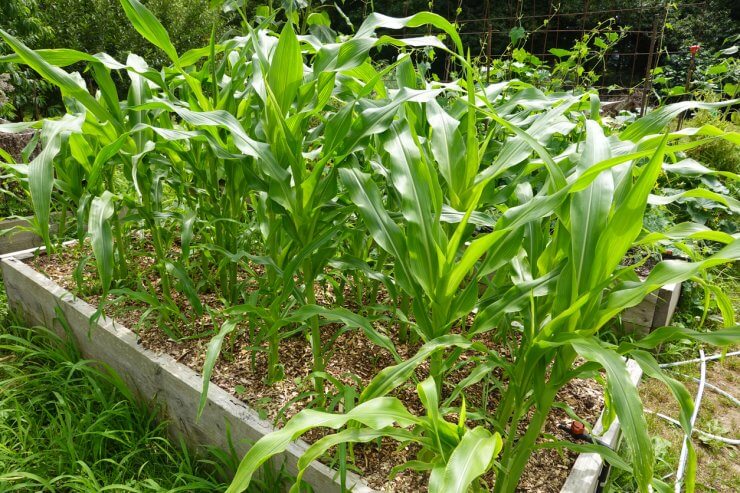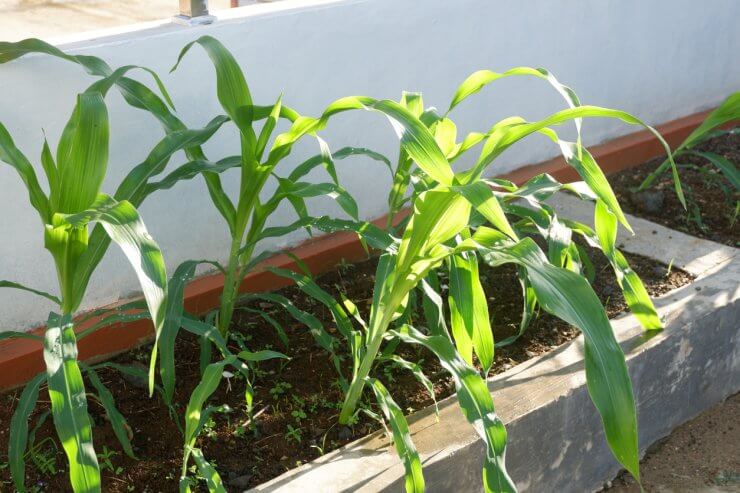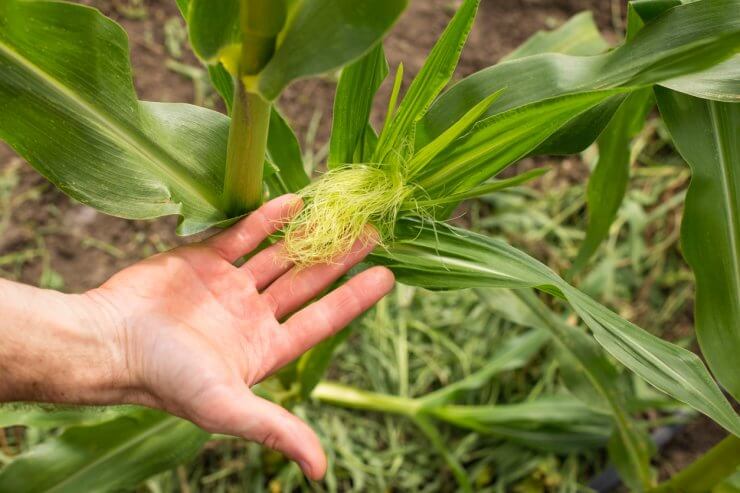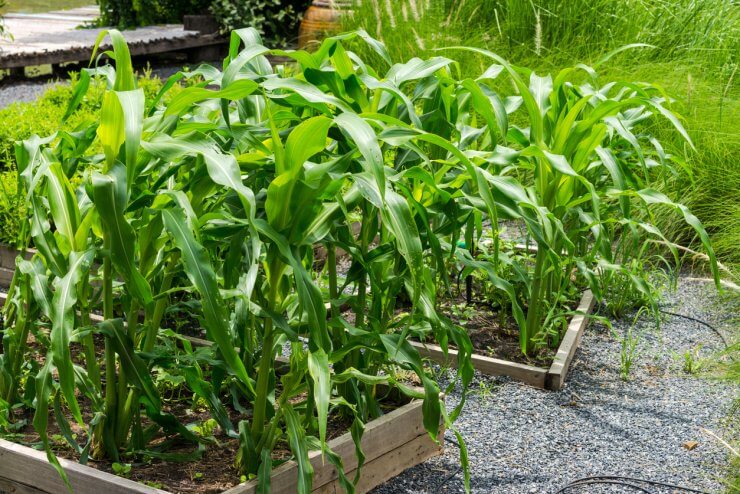
Last weekend at a friend’s barbecue, they excitedly showed me their new plot for growing corn. My friend was so excited that I didn’t notice until that very moment, at the peak of the afternoon, that her plot was very much shaded. Luckily, another friend chimed in, so I didn’t have to be the know-it-all this time. In her case, at least, she had plenty of room to grow a pretty big plot of corn if she really wanted to—some people aren’t so lucky, but it can be done!
Listen, I get it. When you mention growing sweet corn in small spaces, most people give you the same look they’d reserve for someone claiming they’re going to raise cattle in their studio apartment. But here’s the thing: conventional wisdom about corn needing endless acres is about as outdated as dial-up internet.
Sweet corn in containers and tiny plots isn’t just possible–it’s actually superior in some ways to field growing. And I’m about to prove it with science, strategy, and a healthy dose of gardening rebellion.
The Sweet Corn Time Bomb: Why Homegrown Changes Everything
Here’s your first corn fact: the moment you harvest sweet corn, enzymes immediately start converting those precious sugars into bland starch. We’re talking about a vegetable that literally gets less delicious by the hour. Commercial corn can lose up to 40% of its sweetness within 6 hours of harvest.
This is why corn enthusiasts (and yes, corn enthusiasts are absolutely a thing) will literally set timers around harvest time. They’re not being dramatic–they’re being scientifically accurate.
When you grow your own, you control the harvest-to-table timeline. That grocery store corn that traveled hundreds of miles and sat on shelves for days? It’s basically corn’s tired, less interesting cousin.
The Small-Space Advantages:
- Peak freshness (obviously)
- Variety experimentation with cultivars that never make it to stores
- Manageable pest monitoring (more on this scientific warfare later)
- The undeniable satisfaction of producing a “field crop” in unconventional spaces
Corn’s Non-Negotiable Sun Demands
Let’s address the elephant in the garden: corn is absolutely, uncompromisingly obsessed with sunlight. We’re talking 6–8 hours of direct sun minimum, with more being exponentially better.
The Science Behind the Obsession: Corn is what botanists call a C4 plant, meaning it has a turbocharged photosynthesis system that’s roughly 50% more efficient than regular plants (C3 plants). But this agricultural Ferrari engine requires premium fuel–intense, direct sunlight.
Stick corn in partial shade and you’re essentially asking a race car to run on cooking oil. Technically possible, but the results will be underwhelming at best and catastrophic at worst.
Your mission: find the absolute sunniest spot in your space. Yes, this might mean relocating your prized flower arrangements. Priorities, people.

Can You Do Containers?
Traditional field corn sends roots 6 feet deep and 3 feet wide. In containers, you’re essentially asking your corn to live in a high-rise apartment instead of a sprawling ranch house. The amenities better be exceptional.
Container Specifications:
- Minimum depth: 12 inches (though 16–18 inches is noticeably better)
- Width: As wide as possible for stability
- Volume sweet spot: 30-gallon containers can support 9–12 plants
- Drainage: Critical–corn likes consistent moisture but despises waterlogged roots
The Physics Problem: Corn grows tall and develops a relatively small root system compared to its height. This creates a tipping hazard in containers. Wider bases and heavier containers solve this engineering challenge.
You will also be hand-pollinating anything in a container. While it’s not impossible, consider it a science project.
Matching Corn Personality to Space Reality
Not all sweet corn varieties are created equal for small spaces. Here’s where genetics meets practicality:
Compact Varieties (The Space Savers):
- ‘Patio Pride’ – specifically bred for containers
- ‘On Deck’ – dwarf variety reaching only 4–5 feet
- ‘Trinity’ – compact bicolor with excellent flavor
Early Varieties (The Speed Demons):
- ‘Early Sunglow’ – 63 days to harvest
- ‘Earlivee’ – 58 days, perfect for short seasons
- ‘Quickie’ – lives up to its name at 60 days
The Sweet Corn Science: Modern sweet corn falls into three main genetic categories:
- Su (Standard): Traditional sweet corn
- SE (Sugary Enhanced): Higher sugar content, better texture
- Sh2 (Supersweet): Extremely high sugar, but requires isolation from other corn types
Critical Genetics Note: Sh2 varieties need to be grown at least 100 feet from other corn types or planted 2+ weeks apart to prevent cross-pollination that results in starchy, disappointing kernels.

Orchestrating Corn Romance
This is where corn gets agriculturally dramatic. Unlike self-pollinating plants, corn requires wind-blown pollen to travel from tassels (male flowers) to silks (female flowers). Each silk connects to a potential kernel–miss pollinating one silk, and you get a gap in your ear.
Block Planting Strategy: Instead of traditional rows, plant corn in tight blocks. A 4×4 foot block creates optimal conditions for pollen distribution. Think of it as engineering a microclimate for successful corn reproduction.
Hand Pollination Technique: In ultra-small spaces, wind might not be sufficient. Enter agricultural matchmaking:
- Timing: Pollen sheds in early morning, typically 9–11 AM
- Collection: Gently tap tassels into a small container or paper bag
- Application: Use a small paintbrush to apply pollen to silks
- Frequency: Repeat daily for 5–7 days once silks emerge
This isn’t just backup insurance–in small plots, hand pollination often produces more uniformly filled ears than wind pollination alone.
Water and Nutrition
Corn is essentially a giant grass that can transpire (plant equivalent of sweating) up to 4 gallons of water per day during peak growth. In containers, this translates to potentially twice-daily watering during hot weather.
The Nitrogen Addiction: Corn consumes nitrogen like a biological vacuum cleaner. Side-dress with nitrogen fertilizer at two critical periods:
- When plants reach knee-high (8–10 leaf stage)
- When silks first emerge
Container-Specific Challenges: Nutrients leach from containers faster than ground soil. Liquid feeding every 2–3 weeks supplements the initial soil preparation.

Pest Management
Small-space growing offers pest management advantages, but corn earworm remains public enemy number one.
The Mineral Oil Weapon: Once silks begin browning (indicating pollination is complete), apply 2–3 drops of mineral oil to the silk tips. This creates an impenetrable barrier for earworm larvae–basically agricultural warfare at the microscopic level.
Timing is Critical: Apply too early and you interfere with pollination. Apply too late and larvae have already entered the ear.
Harvest Timing
Sweet corn harvest timing is more precise than most vegetables. You’re aiming for the “milk stage”–typically 18–24 days after silk emergence.
The Fingernail Test: Pierce a kernel with your fingernail. Milky juice indicates perfect timing. Clear juice means wait a few more days. Thick, pasty juice means you’ve missed the window.
The Sugar Conversion Race: Once optimal ripeness is reached, sugar-to-starch conversion accelerates rapidly. From harvest to cooking pot should take less than 30 minutes for maximum sweetness.
Growing sweet corn in small spaces requires more attention than field corn, but the payoff is extraordinary. Or at least, it’s fun. And maybe you’ll have a finger sized ear of corn your first year, but maybe you’ll have a whole batch!
The next time someone tells you corn needs acres to grow properly, just smile and start planning your container corn empire. Science, strategy, and a little rebellious gardening spirit are all you need.
Final Corn Nerd Fact: A single ear of corn contains approximately 800 kernels arranged in 16 rows. In small spaces, you’re essentially running a high-efficiency kernel production operation. Embrace your inner agricultural engineer.
Corn is an all-American staple! Want to know more about growing it? With The Everything Corn Gardening Guide, you’ll have everything you need to know about growing and enjoying this unique food in your home garden, including advice on planting, raising, harvesting, and preparing dish after delicious dish featuring your home-grown corn.
Warning: Growing your own sweet corn may result in corn snobbery, excessive harvest-timing precision, and the inability to enjoy grocery store corn ever again. Side effects include spontaneous corn variety research and uncontrollable urges to hand-pollinate everything.


 Previous
Previous

